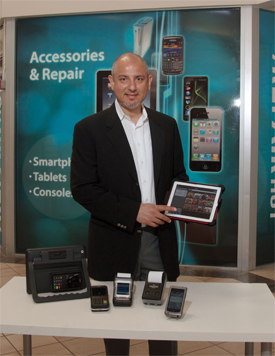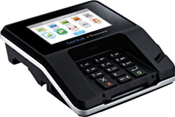3 Benefits Of Selling SaaS-Based POS
By Matt Pillar, Business Solutions magazine
eMobilePOS anticipates triple-digit growth on the sale of its SaaS-based POS solutions. Here’s why the company is banking on the cloud.

e-Nabler, the parent company of eMobilePOS, is what some marketing and PR-types in the retail solutions channel might call disruptive (using the term in a positive connotation, as marketing and PR-types do). Back in 2003, when a retail technology reseller could still make a good living on PC-based POS and local network/server sales, e-Nabler was pitching a mobile DSD (direct store delivery) and field sales transaction platform on the first version of Windows Mobile. By then, the company had already been selling subscriptions to its Webbased software service for three years. In other words, it was selling mobile hardware, which ran Web-based transaction solutions, back when the term “cloud” only made sense to the guys in horn-rim glasses in the back rooms at Google, Amazon, and Salesforce.com. That’s what those marketing and PR types mean when they say “disruptive.”
Matthew Inan, director of business development and channel sales for eMobilePOS, says the recent, explosive interest in mobile POS — particularly in the specialty retail and hospitality segments — was a natural extension for the independent software vendor (ISV). “In principle, mobile POS and our field/route sales roots require hardware and transactional software that’s one and the same,” he says. “We made some minor adjustments to our software to accommodate nuances like product attributes, but moving into mobile POS was a natural progression that didn’t require too much heavy lifting.”
It’s a progression that also paid off big, and quickly. Those minor adjustments paved the way for development of eMobilePOS solutions for Windows, Apple, and Android devices that earned the company honors for AT&T’s “Best New Mobile App” during CTIA 2008 and garnered it an RSPA Innovative Solution Award at RetailNOW 2011. More importantly, those solutions contributed to 50% more revenue for the company last year, a growth figure it expects to triple in 2013. POS VARs and integrators can learn a few things from Inan and eMobile POS about how the SaaS/mobile combination is not only a sales builder, but also a profit booster.
SaaS Requires A Smaller Investment
As an ISV, eMobilePOS writes all the code for its mobile POS software inhouse, and write code it does. Inan says federally funded research and development status allows the company to dedicate a full 75% of its budget to R&D, with the remainder dedicated to channel development and sales support. All of the software eMobilePOS develops is cloud-based and offered by subscription via the SaaS model only, a strategic decision that has significant downstream cost-reduction implications. “Cloud services make it easier for both resellers and retailers to access our mobile POS solution, putting it within reach from a cost perspective,” explains Inan. Specifically, removing up-front capital expenses such as servers, licenses, and — increasingly — the POS hardware itself in favor of a subscription-based service lowers the barrier to entry for resellers and retailers, thus broadening the market for eMobilePOS.
Key to the pitch is the ability to demonstrate how the SaaS model mitigates the risks associated with not only capital outlay, but also implementation failure and technology obsolescence. While no VAR or integrator wants to suggest up front that its solution might fail or its technology might become obsolete, cloud-based SaaS and the new HaaS (Hardware as a Service) concept give end users peace of mind that their minimal monthly investment won’t result in the embarrassing, expensive, and long-term “sunsetting” of a new rollout. This is specifically important in the context of mobile POS, where rapid handheld device obsolescence among virtually all manufacturers has created an opportunity for solutions providers to lease the latest hardware to retailers, eliminating those customers’ concerns about a short — and expensive — upgrade cycle.
Subscription-Based Software Results In Predictable Financials
Another major benefit of adopting a SaaS sales and delivery model is the financially predictable relationship it creates for VARs and their merchant customers. “Servicebased relationships lend themselves to subscription-based payment models,” says Inan. “This has many advantages, beginning with the fact that the expenses incurred by the customer and the income received by the VAR are far less cyclical. The traditional license-based software sales market is just as cyclical as packaged goods; you sell more at the beginning of the year, sales dwindle as budgets are exhausted, and the result is a heavy burden of financial responsibility,” he says. Specifically, Inan says cyclical income forces VARs to maintain their initial up-front license income to fund operating expenses and growth throughout the year. In the SaaS model, financial responsibility is more predictable, income more sustainable, and midterm profit higher.
In a presentation at this year’s RSPA INSPIRE event last quarter, consultant Tom Bouwer demonstrated a hypothetical scenario in which a VAR who won 12 new $10,000 deals in year one and built that up to 72 total customers by year three would earn $410,000. The same number of customers buying the same software, hardware, and services in the traditional model yields a relatively paltry $251,000. (Check out Business Solutions Editor In Chief Mike Monocello’s blog post on the subject at www.bsminfo.com/ go/saas-example.)
Of course, there’s a degree of discomfort in foregoing up-front lump sum payments in favor of smaller longterm installments, even though those installments are sure to add up to more money. Inan says those concerns — which include the potential that you’ll take a loss the first year — can be mitigated by treading carefully into SaaS and capitalizing on up-front revenue opportunities such as hardware, training, and support service contracts. For willing and able VARs, Inan points to up-front customization as a tangible service that can contribute to immediate payback on SaaS deals.
SaaS Is A Mobile POS Enabler
There’s a profound shift occurring at the POS, the likes of which the industry hasn’t seen since PCs began to displace electronic cash registers. Analysts and research firms are predicting that some 75% of retailers will have piloted or deployed mobile POS by the end of this year, and they’re not just toying with it. JCPenney, for instance, has vowed to replace its entire fixed POS infrastructure with mobile POS by the end of 2013. “We can see that over the course of the past 18 months, the channel has really awoken to the shift toward mobility. There is tremendous awareness,” says Inan. “However, the transition from a ‘buy at X, sell at Y, and make W’ model to a SaaS model is taking some time.”
To accommodate the appetite for mobile, however, Inan says that transition must speed up, because the anywhere, anytime attributes of cloud computing and mobile POS make them a perfect match. “The channel needs to increase efforts and educational programs to train VARs and increase their awareness of the successes of those who have transitioned to a SaaS-based model,” says Inan. “We have reached the point where distributors have to be prepared to equip VARs with the solution bundles that will enable cloud-based mobile POS.” The imminence in his voice leads to the warning that everything we’ve known about POS is about to change. “Mobile POS will replace box-based or PC-based POS systems within the next two years,” he says. “By 2015, no one will be selling PC-based POS solutions anymore.”
Coming from just about anyone else, that might sound a little brash. But, given their track record of success with SaaS and mobile POS, Inan and company deserve the benefit of the doubt.

